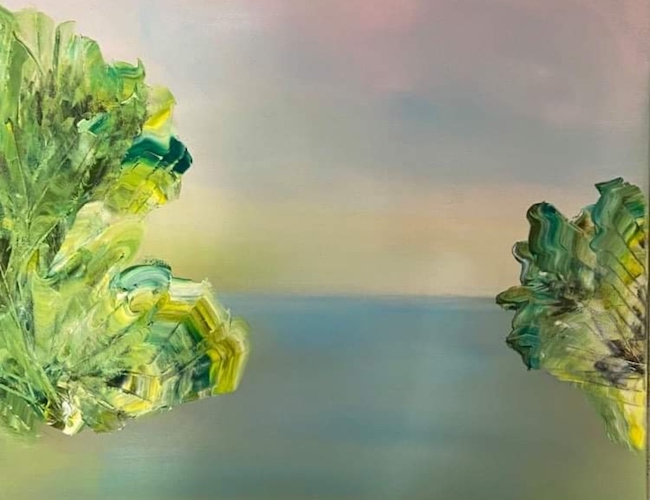Il percorso esistenziale contemporaneo è alla base della produzione artistica di molti creativi i quali sentono la necessità di esprimere, o meglio lasciar fuoriuscire, quelle sensazioni sotterranee che manifestano non solo il loro stato d’animo bensì si ampliano e si accordano a un sentire comune, a una rappresentazione di tutta quella gamma emozionale in cui l’osservatore si sente coinvolto pur non essendo capace di affrontare da solo il medesimo percorso introspettivo. L’artista di cui vi parlerò oggi si muove in quel morbido mondo di sensazioni profonde utilizzando uno stile immediato e fortemente interpretativo.
La spaccatura tra adesione alla realtà osservata e tensione verso l’abbandono di ogni forma conosciuta per affermare la supremazia del gesto creativo su qualsiasi canone estetico e plastico fu uno dei temi principali di quell’inizio del Ventesimo secolo che fu contraddistinto da una vera e propria rivoluzione culturale e artistica; malgrado il diffondersi dell’Astrattismo a livello europeo, in breve tempo si giunse alla conclusione che l’arte non potesse prescindere dall’impulso emotivo perché altrimenti sarebbe rimasta incomprensibile, se non per una ristretta élite di intellettuali, e distante da quel coinvolgimento che invece appartiene alla natura stessa della manifestazione creativa. Il primo ad affermare la necessità di introdurre nell’opera astratta la forza spirituale fu uno dei fondatori nonché massimi esponenti dell’Astrattismo Lirico, Vasilij Kandinskij, scontrandosi con le coeve correnti, come l’Astrattismo Geometrico, il Suprematismo Russo, il De Stijl, che volevano invece distaccarsi completamente dal mondo emotivo, psicologico, interiore della creazione per prediligere un approccio scientifico e matematico, privo di ogni ingerenza soggettiva dell’artista. Nel proseguire del periodo storico si andò delineando, soprattutto negli Stati Uniti sebbene poi si diffuse in tutto il mondo, una nuova corrente pittorica, l’Espressionismo Astratto, dove non esistevano più regole pittoriche o stilistiche bensì solo la libertà di esprimere l’impellente oppure meditato o entusiasta stato d’animo; fu attraverso questo movimento che l’emozione assunse un ruolo di assoluto rilievo su qualsiasi altro intento espressivo, emozione raccontata in maniera impetuosa come nell’Action Painting di Jackson Pollock, o meditativa come nel Color Field di Mark Rothko o ancora impulsivamente essenziale come nella pittura segnica di Franz Kline. Il loro approccio pittorico, legato alla spontaneità del gesto creativo e dell’inesistenza di regole prospettiche, cromatiche o di una struttura di base costituita dal disegno, aprì le porte dell’arte a un pubblico più ampio in grado di lasciarsi affascinare dall’intensità delle vibrazioni che le tele suscitavano nella loro interiorità. L’assoluta assenza di figurazione della maggior parte degli appartenenti all’Espressionismo Astratto, viene tuttavia superata nel proseguire del secolo e, soprattutto, nell’arte contemporanea dove la sovrapposizione tra visibile e astrazione, tra realtà osservata e semplice intuizione di un sentire interiore, permette ad alcuni artisti di dare vita a nuovi linguaggi stilistici, a inganni visivi in cui l’occhio si perde pur restando legati a un’astrazione di base in grado di lasciare all’osservante grande libertà interpretativa. Elvira Kujovic, traduttrice e poetessa tedesca con origini serbe, si avvicina alla pittura in maniera spontanea, come se quest’ultima fosse un’evoluzione del suo linguaggio, quello poetico, e al tempo stesso ne divenisse un’estensione, un ampliamento che le permette di esprimere le sue sensazioni anche attraverso colori e immagini.
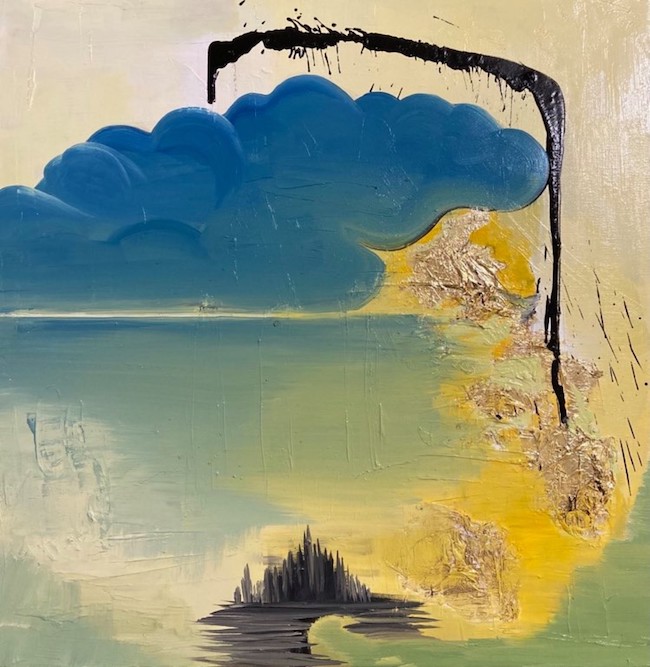
La scelta naturale e istintiva che compie è quella di avvicinarsi a uno stile che non abbia regole, che non la induca a restare all’interno del formalismo e della rigorosità che contraddistinguono invece il linguaggio scritto; le sue opere sono un accordo tra la melodia poetica e la necessità dello sguardo di dare concretezza ai versi, evocando così atmosfere sospese tra sogno e realtà di forte impatto emotivo.
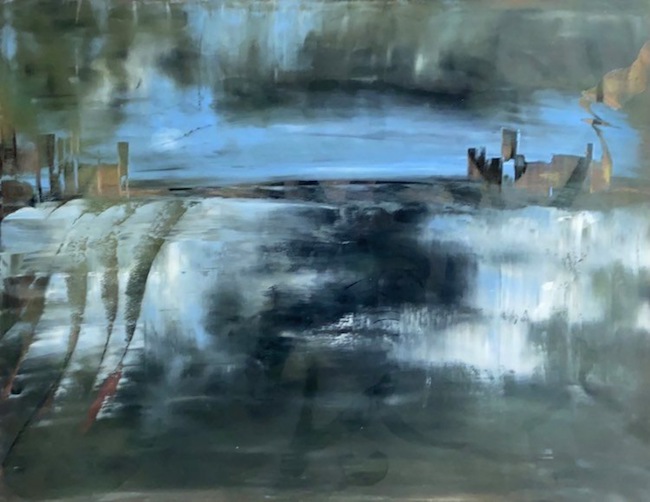
I titoli non sono essenziali per la Kujiovic anzi, preferisce lasciare a chi guarda la libertà di avvicinarsi emotivamente all’opera senza alcun condizionamento, senza avere una traccia che in qualche modo sarebbe una guida inconscia, bensì permettendo che le immagini suggestive si aggancino alle emozioni per unirsi in un sentire comune, condiviso, in un accordo perfetto con la gamma cromatica e il fluire emozionale. I luoghi narrati da Elvira Kujovic sono paesaggi irreali, panorami ideali in cui la fantasia si perde e da cui l’animo si sente avvolto, cullato dalla pace e dalla distensione che i colori e le atmosfere rarefatte ispirano; sembra quasi di percepire i suoni dei versi poetici dell’artista in quel silenzio che avvolge le sue tele, in quei panorami sospesi tra acqua e cielo, tra terra e natura circostante che potrebbero trovarsi ovunque e da nessuna parte.
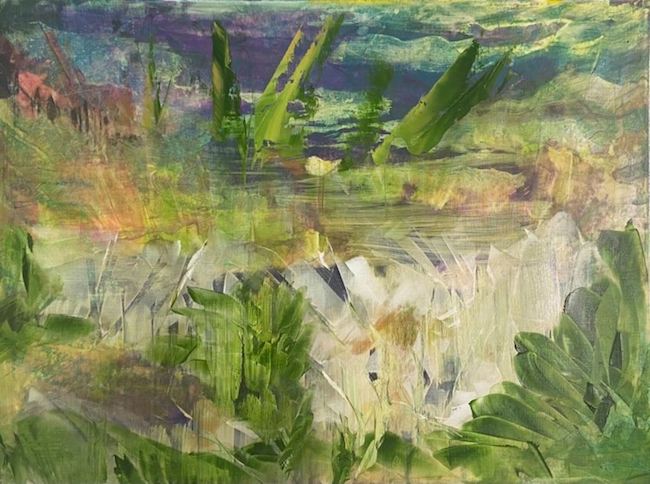
Ciò che emerge in maniera nitida è la ricerca della pace, della tranquillità, come se l’arte dovesse costituire un rifugio da una realtà troppo avversa, ostile per un animo delicato e sensibile costretto però a ergere una corazza per affrontare la contingenza.

È quello lo spazio ricercato dalla Kujovic, quella connessione con l’interiorità attraverso la quale conduce l’osservatore verso le sue profondità, verso la coscienza di quanto in realtà sia necessario fermarsi e riflettere su se stessi, sulle sensazioni solo distrattamente ascoltate ma che, in virtù dell’esortazione sottile dell’artista, riescono a emergere in maniera lieve, delicata, spontanea proprio perché sollecitate dall’aspetto rassicurante delle immagini narrate. Dunque l’Espressionismo Astratto viene declinato nella sua accezione più meditativa, più calma, seppur mantenendo quell’illusione di figurazione da cui lo sguardo viene attratto per poi perdersi nella sua indefinitezza, nel suo esistere e contemporaneamente nel suo non esistere se non all’interno di un mondo interiore che sembra aprirsi e abbandonarsi davanti alle tonalità a volte tenui e altre più intense ma sempre avvolgenti delle tele di Elvira Kujovic.
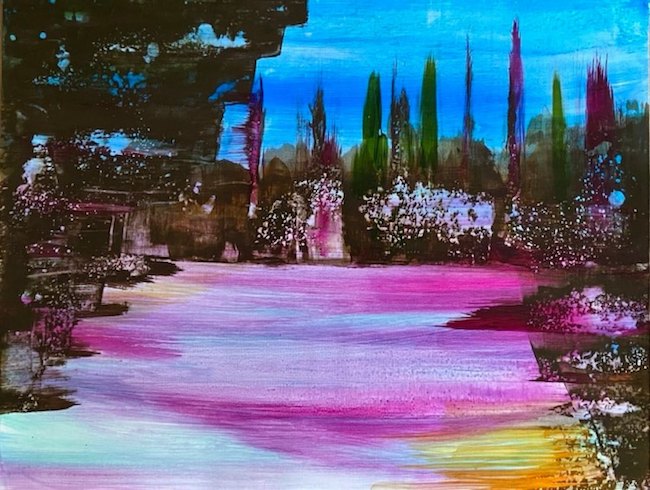
Nell’opera Orient (Oriente) l’artista lascia emergere il fascino di una terra che da sempre rappresenta il mistero, la pacatezza e l’attenzione verso l’individualità, verso un sé interiore che costituisce autoconsapevolezza e tendenza a un maggiore rispetto dell’altro come diverso ed esterno a sé, non come un’antagonista o un opposto bensì semplicemente qualcuno che può arricchire la propria interiorità in virtù di ciò che lo differenzia da noi; questa tendenza armonica si espande anche all’ambiente circostante, un luogo in cui la gamma cromatica scelta non è reale, non appartiene al conosciuto piuttosto a quelle sfumature dell’anima attraverso cui l’artista osserva o immagina la realtà.
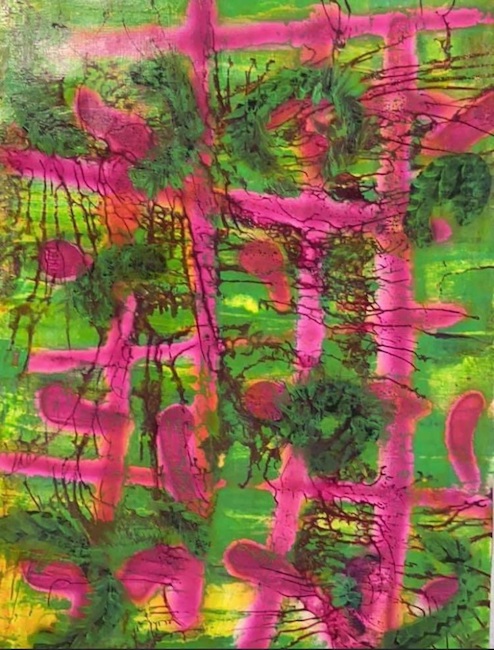
Ed è ancora l’anima con le sue profondità, con i suoi timori e con i suoi disagi, a essere protagonista anche della tela The soul in prison (L’anima in prigione), dove le speranze, la vitalità, i desideri sembrano essere intrappolati dalla contingenza, dall’impossibilità di manifestarsi liberamente perché soffocati da un circostante che infonde cupezza, insicurezza. In questo dipinto la Kujovic vira verso la pura astrazione necessaria per descrivere ciò che per definizione è indefinibile, che non ha corpo e non ha forma pur avendo in sé l’incredibile forza di dominare il mondo delle emozioni; è esattamente a quella forza che attinge l’artista utilizzando il colore rosa per rappresentare una gabbia che può dissolversi se solo l’individuo decidesse di ascoltare le sue pulsioni anziché farsi fermare da un’oggettività esterna a sé che ha un potere solo apparente.
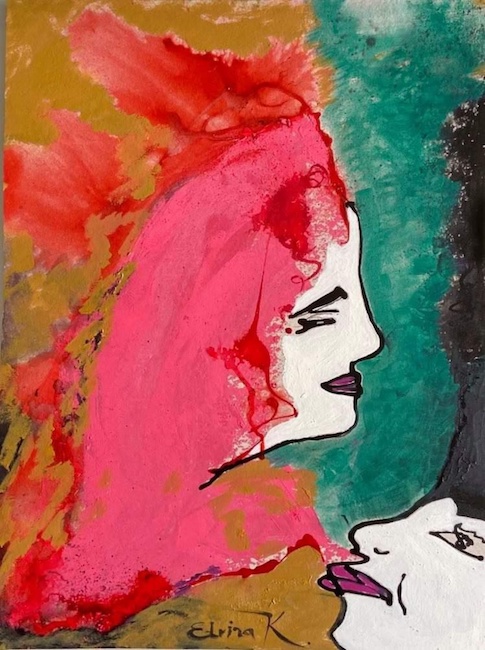
Elvira Kujovic ha pubblicato otto raccolte di poesie e un romanzo, le sue poesie sono state tradotte in quindici lingue e i suoi libri pubblicati in nove paesi, e da circa un anno ha sentito di dover ampliare i suoi canali espressivi entrando nel mondo dell’arte visiva, dimostrando quanto la sperimentazione creativa abbia spesso bisogno di manifestarsi a livelli differenti ma sempre fortemente armonici.
ELVIRA KUJOVIC-CONTATTI
Email: elvira.kujovic@outlook.de
Facebook: https://www.facebook.com/elvira.kujovic
Instagram: https://www.instagram.com/elvirakujovic/
Linkedin: https://www.linkedin.com/in/elvira-kujovic-75453716/
Elvira Kujovic, poetry and painting to nourish the listening to the depths of human soul
The contemporary existential path is at the basis of the artistic production of many creatives who feel the need to express, or rather to let out, those subterranean sensations that not only manifest their state of mind but also expand and are in tune with a common feeling, with a representation of the entire emotional range in which the observer feels involved even though he is not capable of facing the same introspective path alone. The artist I am going to talk about today moves in that soft world of deep sensations using an immediate and strongly interpretative style.
The split between adherence to observed reality and the tension towards the abandonment of all known forms in order to affirm the supremacy of the creative gesture over any aesthetic and plastic canon was one of the main themes of the beginning of the 20th century, which was marked by a true cultural and artistic revolution; despite the spread of Abstractionism in Europe, it was soon concluded that art could not be separated from the emotional impulse because otherwise it would remain incomprehensible, if not for a small elite of intellectuals, and distant from the involvement that belongs to the very nature of creative manifestation. The first to affirm the need to introduce spiritual force into the abstract work was one of the founders and greatest exponents of Lyrical Abstractionism, Vasily Kandinsky, who clashed with contemporary currents such as Geometric Abstractionism, Russian Suprematism and De Stijl, which wanted to completely detach themselves from the emotional, psychological and inner world of creation in favour of a scientific and mathematical approach, devoid of any subjective interference by the artist.
As the historical period continued, a new pictorial current, Abstract Expressionism, began to emerge, especially in the United States, although it then spread throughout the worldm that had no pictorial or stylistic rules but only the freedom to express the impelling or meditated or enthusiastic state of mind; it was through this movement that emotion assumed a role of absolute prominence over any other expressive intent, emotion told in an impetuous way as in Jackson Pollock’s Action Painting, or meditative as in Mark Rothko’s Color Field or even impulsively essential as in Franz Kline’s sign painting. Their pictorial approach, linked to the spontaneity of the creative gesture and the inexistence of rules of perspective, colour or a basic structure constituted by the drawing, opened the doors of art to a wider public able to be fascinated by the intensity of the vibrations that the canvases aroused in their interiority.
The absolute absence of figuration of most of the members of Abstract Expressionism was overcome as the century went on and, above all, in contemporary art, where the overlap between the visible and abstraction, between observed reality and the simple intuition of an inner feeling, allowed some artists to create new stylistic languages, visual tricks in which the eye can get lost while remaining linked to a basic abstraction that leaves the observer great freedom of interpretation. Elvira Kujovic, a German translator and poet of Serbian origin, approached painting spontaneously, as if it were an evolution of her language, that of poetry, and at the same time became an extension of it, a widening that allows her to express her sensations also through colours and images. The natural and instinctive choice she makes is to approach a style that has no rules, that does not induce her to remain within the formalism and rigour that distinguish written language; her artworks are an agreement between poetic melody and the need for the eye to give substance to the verses, thus evoking atmospheres suspended between dream and reality with a strong emotional impact. The titles are not essential for Kujiovic, on the contrary, she prefers to leave the viewer free to approach the artwork emotionally without any conditioning, without having a trace that would in some way be an unconscious guide, but rather allowing the suggestive images to latch on to the emotions to unite in a common, shared feeling, in perfect agreement with the chromatic range and the emotional flow. The places narrated by Elvira Kujovic are unreal landscapes, ideal panoramas in which the imagination loses itself and by which the soul feels enveloped, cradled by the peace and relaxation that the colours and rarefied atmospheres inspire; it almost seems as to hear the sounds of the artist’s poetic verses in the silence that envelops her canvases, in those landscapes suspended between water and sky, between earth and surrounding nature, which could be anywhere and nowhere else. What emerges clearly is the search for peace and tranquillity, as if art were to provide a refuge from a reality that is too adverse, hostile for a delicate and sensitive soul forced, however, to erect an armour to deal with contingency.
This is the space searched by Kujovic, the connection with interiority through which she leads the observer towards her own depths, towards the awareness of how necessary it is to stop and reflect on oneself, on the sensations only distractedly heard but which, by virtue of the artist’s subtle exhortation, manage to emerge in a light, delicate, spontaneous manner precisely because they are stimulated by the reassuring aspect of the images narrated. Abstract Expressionism is thus declined in its more meditative, calmer meaning, although it maintains that illusion of figuration from which the eye is attracted and then lost in its indefiniteness, in its existence and at the same time in its non-existence if not within an inner world that seems to open up and abandon itself before the sometimes soft and sometimes more intense but always enveloping tones of Elvira Kujovic’s canvases. In the artwork Orient (East) the artist brings out the fascination of a land that has always represented mystery, calmness and attention to individuality, to an inner that constitutes self-awareness and a tendency towards greater respect for the other as different and external to oneself, not as an antagonist or an opposite but simply someone who can enrich one’s interiority by virtue of what differentiates him from us; this harmonic tendency also extends to the surrounding environment, a place where the chromatic range chosen is not real, it does not belong to the known rather to those nuances of the soul through which the artist observes or imagines reality.
The soul, with its depths, its fears and its discomforts, is also the protagonist of the canvas Soul in prison, where hopes, vitality and desires seem to be trapped by contingency, by the impossibility of expressing themselves freely because they are suffocated by surroundings that instil gloom and insecurity. In this painting, Kujovic turns towards the pure abstraction needed to describe what is by definition indefinable, what has no body and no form despite having the incredible power to dominate the world of emotions; it is precisely this power that the artist draws on, using the colour pink to represent a cage that could dissolve if only the individual would decide to listen to his impulses instead of letting himself be stopped by an external objectivity that has only apparent power. Elvira Kujovic has published eight collections of poems and a novel, her poems have been translated into fifteen languages and her books published in nine countries. About a year ago she felt she had to broaden her expressive channels by entering the world of visual art, demonstrating how creative experimentation often needs to manifest itself on different but always strongly harmonious levels.


